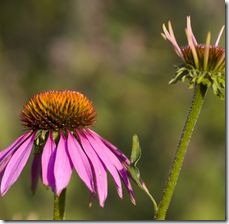 Also known as echinacea and black samson, the purple coneflower is a native North American wildflower renowned for its medicinal properties. Associated most commonly with the Great Plains, it can be found in sunny, dry locations from Texas to Canada and the Rocky Mountains to Kentucky. There are nine species of purple coneflower, two of which are on the U.S. federal endangered species list. While all purple coneflowers share certain broad characteristics, precise identification of a particular species can be a challenge due to hybridization.
Also known as echinacea and black samson, the purple coneflower is a native North American wildflower renowned for its medicinal properties. Associated most commonly with the Great Plains, it can be found in sunny, dry locations from Texas to Canada and the Rocky Mountains to Kentucky. There are nine species of purple coneflower, two of which are on the U.S. federal endangered species list. While all purple coneflowers share certain broad characteristics, precise identification of a particular species can be a challenge due to hybridization.
- Difficulty:
- Moderately Easy
Instructions
- Examine the flowers, if present. Purple coneflower is often described as "daisy-like." Bloom color ranges from deep reddish-purple to white. Petals are numerous, narrow and droop downward from a spiny cone located in the center of the flower. Flowers appear from early to late summer.
- Feel the leaves, which are covered in short prickly hairs and will feel like sandpaper. They are staggered along the plant stem rather than positioned across from each other. Leaf shape varies from oblong to lance-shaped. You will find larger leaves with a long leaf stem lower on the plant, while smaller leaves with no leaf stem are found closer to the flowers.
- Look at the stem of the plant. Stems have an erect, upright appearance. Purple coneflower stems, like their leaves, feel rough to the touch. They can appear individually or in groups of two to five. The top 6 to 10 inches of a purple coneflower stem is usually leafless.
- Consider the height of the plant. Purple coneflower grows 2 to 5 feet tall, with plants located at higher altitudes and in Canada growing shorter. The height of purple coneflower plants tends to increase the further east in its range you go.
Tips & Warnings
-
If you’ve spotted a plant that matches the description of purple coneflower on all counts except for its yellow flowers, you’re probably looking at Echinacea paradoxa, a species of coneflower which grows in dry, prairie locations from the Ozarks of Kansas and Arkansas to Missouri and north Texas.
-
Some species of purple coneflower are endangered. Never dig up a plant from its natural habitat—if you want to add coneflowers to your garden, purchase a plant or two from your local garden center or nursery.

Deprecated: strpos(): Passing null to parameter #1 ($haystack) of type string is deprecated in /home/agriviek8Qv/agriviet.net/public_html/wp-includes/comment-template.php on line 2522